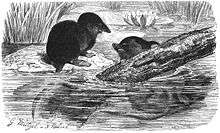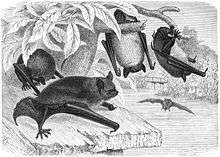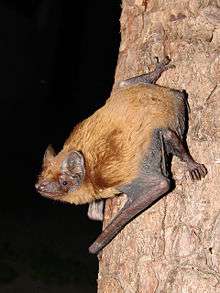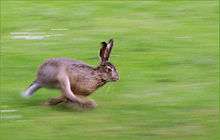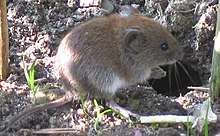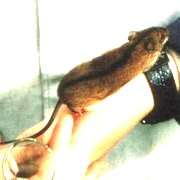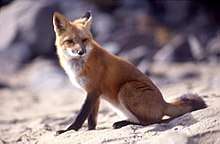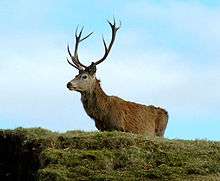List of mammals of Denmark
This is a list of the mammal species recorded in Denmark. The main source is the most recent atlas survey of mammals in Denmark.[1] The atlas records 88 mammal species in Denmark. Since the atlas was published in 2007 three new species have been recorded: grey wolf, golden jackal and Cuvier's beaked whale.
The following tags are used to highlight each species' conservation status in the most current version of the Danish Red List.[2] Assessments were made following recommendations of the International Union for Conservation of Nature.
| EX | Extinct | No reasonable doubt that the last individual has died. |
| EW | Extinct in the wild | Known only to survive in captivity or as a naturalized populations well outside its previous range. |
| RE | Regionally extinct | No reasonable doubt that the species no longer exist in the assessed region |
| CR | Critically endangered | The species is in imminent risk of extinction in the wild. |
| EN | Endangered | The species is facing an extremely high risk of extinction in the wild. |
| VU | Vulnerable | The species is facing a high risk of extinction in the wild. |
| NT | Near threatened | The species does not meet any of the criteria that would categorise it as risking extinction but it is likely to do so in the future. |
| LC | Least concern | There are no current identifiable risks to the species. |
| DD | Data deficient | There is inadequate information to make an assessment of the risks to this species. |
| NA | Not assessed | Not assessed, either because it is an invading/naturalised species, or extremely rare visitor |
Eulipotyphlans
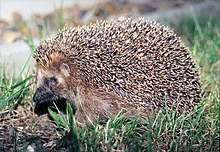
West European hedgehog
Erinaceidae (hedgehogs)
- West European hedgehog, Erinaceus europaeus LC
Talpidae (moles)
- European mole, Talpa europaea LC
Soricidae (shrews)
- Eurasian water shrew, Neomys fodiens NT
- Common shrew, Sorex araneus LC
- Eurasian pygmy shrew, Sorex minutus LC
Bats
Vespertilionidae (evening bats)
- Barbastelle, Barbastella barbastellus NT
- Serotine bat, Eptesicus serotinus LC
- Northern bat, Eptesicus nilssonii DD
- Bechstein's bat, Myotis bechsteinii EN
- Brandt's bat, Myotis brandti NT
- Pond bat, Myotis dasycneme VU
- Daubenton's bat, Myotis daubentonii LC
- Greater mouse-eared bat, Myotis myotis NA
- Whiskered bat, Myotis mystacinus VU
- Natterer's bat, Myotis nattereri NT
- Common noctule, Nyctalus noctula LC
- Lesser noctule, Nyctalus leisleri DD
- Common pipistrelle, Pipistrellus pipistrellus LC
- Soprano pipistrelle, Pipistrellus pygmaeus LC
- Nathusius's pipistrelle, Pipistrellus nathusii LC
- Brown long-eared bat, Plecotus auritus LC
- Parti-coloured bat, Vespertilio murinus LC
Lagomorphs
Leporidae
- European rabbit, Oryctolagus cuniculus NA
- European hare, Lepus europaeus LC
Rodents
Sciuridae (squirrels)
- Red squirrel, Sciurus vulgaris LC
- Siberian chipmunk, Tamias sibiricus NA (introduced)
Castoridae (beavers)
- Eurasian beaver, Castor fiber EN
Gliridae (doormice)
- Hazel dormouse, Muscardinus avellanarius EN
- Garden dormouse, Eliomys quercinus DD (possibly escaped from captivity)
Cricetidae (voles)
- Water vole, Arvicola terrestris LC
- Bank vole, Myodes glareolus LC
- Field vole, Microtus agrestis LC
- Common vole, Microtus arvalis LC
- Muskrat, Ondatra zibethicus NA (invasive)
Muridae
- Yellow-necked mouse, Apodemus flavicollis LC
- Striped field mouse, Apodemus agrarius LC
- Wood mouse, Apodemus sylvaticus NT
- Harvest mouse, Micromys minutus LC
- Brown rat, Rattus norvegigus NA
- House mouse, Mus musculus NT
- Black rat, Rattus rattus RE
Dipodidae
- Northern birch mouse, Sicista betulina VU
Myocastoridae
- Coypu, Myocastor coypus NA (introduced)
Carnivorans
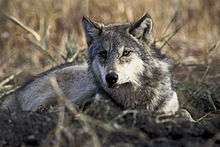
Gray wolf
Canidae (dogs, foxes)
- Red fox, Vulpes vulpes NT
- Eurasian wolf, Canis lupus lupus VU (recently re-invaded from Germany)[3]
- Raccoon dog, Nyctereutes procyonoides NA (invasive)
- Golden jackal, Canis aureus NA (invading from south)[4]
Mustelidae (mustelids)
- Stoat, Mustela erminea NT
- Least weasel, Mustela nivalis NT
- European polecat, Mustela putorius NT
- Beech marten, Martes foina NT
- Pine marten, Martes martes NT
- Eurasian badger, Meles meles LC
- European otter, Lutra lutra VU
- American mink, Neovison vison NA (invasive)
Odobenidae
- Walrus, Odobenus rosmarus NA (rare visitor)
Phocidae (earless seals)
- Hooded seal, Cystophora cristata NA (rare visitor)
- Common seal, Phoca vitulina LC
- Ringed seal, Pusa hispida NA (rare visitor)
- Grey seal, Halichoerus grypus VU
- Harp seal, Pagophilus groenlandicus NA (rare visitor)
Cetacea
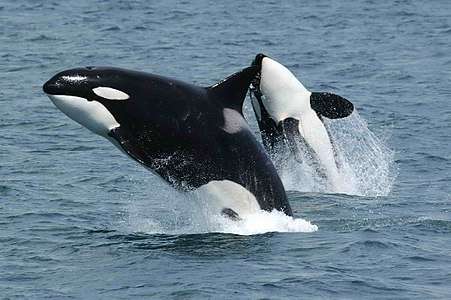
Killer whales jumping
Balaenopteridae
- Blue whale, Balaenoptera musculus NA (rare visitor)
- Sei whale, Balaenoptera borealis NA (rare visitor)
- Bryde's whale, Balaenoptera edeni NA (rare visitor)
- Fin whale, Balaenoptera physalus NA (regular visitor)
- Common minke whale, Balaenoptera acutorostrata LC
- Humpback whale, Megaptera novaeangliae NA (rare visitor)
Phocoenidae (porpoises)
- Harbour porpoise, Phocoena phocoena LC
Monodontidae
- Beluga, Delphinapterus leucas NA (rare visitor)
Physeteridae (sperm whales)
- Sperm whale, Physeter macrocephalus NA (regular visitor)
Ziphidae (beaked whales)
- Sowerby's beaked whale, Mesoplodon bidens NA (rare visitor)
- Northern bottlenose whale, Hyperoodon ampullatus NA (rare visitor)
- Cuvier's beaked whale, Ziphius cavirostris NA (rare visitor)[5]
Delphinidae
- Short-beaked common dolphin, Delphinus delphis NA (regular visitor)
- Striped dolphin, Sternella coeruleoalba NA (rare visitor)
- White-beaked dolphin, Lagenorhynchus albirostris LC
- Atlantic white-sided dolphin, Lagenorhynchus acutus NA
- Bottlenose dolphin, Tursiops truncatus NA (rare visitor)
- Risso's dolphin, Grampus griseus NA (rare visitor)
- False killer whale, Pseudorca crassidens NA (rare visitor)
- Long-finned pilot whale, Globicephala melas NA (regular visitor)
- Orca or killer whale, Orcinus orca NA (rare visitor)
Even-toed ungulates
Suidae (pigs)
- Wild boar, Sus scrofa CR
Cervidae (deer)
- Red deer, Cervus elaphus LC
- Roe deer, Capreolus capreolus LC
- Sika deer, Cervus nippon NA (introduced)
- Fallow deer, Dama dama NA (introduced around 1000 AD)
- Eurasian elk, Alces alces NA (rare visitor from Sweden)
Bovidae (bovid)
- European mouflon, Ovis orientalis musimon NA (introduced)
Procyonidae
- Common raccoon, Procyon lotor NA (invasive)
gollark: A person's economic value *alone* is a few million $, lower bound.
gollark: Probably a person.
gollark: ++delete babies
gollark: I think you could probably make a decent argument that generally having a moral framework in place is beneficial to you because we actually have a functioning society, which benefits you.
gollark: ··.·
References
- Baagøe, Hans; Jensen, Thomas Secher (2007). Dansk Pattedyratlas. Copenhagen: Gyldendal.
- Moeslund, Jesper Erenskjold; et al. (2019). "The Danish Red List". The National Environmental Research Institute, Aarhus University. Retrieved 16 Feb 2020.
- Trolle, Mogens; Jensen, Thomas Secher (2013). Fakta om ulv i Danmark. Aarhus, Denmark: Museum of Natural History.
- "Guldsjakal". Miljøstyrelsen. Retrieved 3 April 2019.
- "Mystisk hval strandet i Danmark". Danmarks Radio. Retrieved 18 February 2020.
This article is issued from Wikipedia. The text is licensed under Creative Commons - Attribution - Sharealike. Additional terms may apply for the media files.
